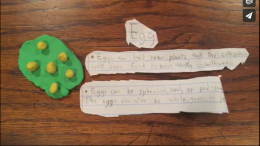This lesson is for : Grade 6:
Summary
Through a cross-curricular project students illustrated their knowledge of the butterfly life cycle through relating it to a character in the book, Surviving the Applewhites. The students focused on one character’s metamorphosis comparing it to the stages of a butterfly’s life cycle. Students demonstrated the development of a character (one character) in Surviving the Applewhites over time. Students explained the similarities between the character and each of the stages of the life cycle. For each stage, they selected a quote that exemplified the character at each stage of their development. They explained the quote and how it compared to the character’s development. Students demonstrated their knowledge through a creative outlet of their choice. As a culminating activity, students traveled to Lewis Ginter Botanical Gardens to observe the Butterflies Live! exhibit, which showcased living specimens of each of the stages of the butterfly life cycle.
TIPC Ratings
Research & Information Fluency
Rating: Approaching – Explanation: In this lesson students reached the approaching category on the TIP chart. Students researched characteristics of the different stages of the life cycle of a butterfly, and synthesized this information to help them create their final product. Students found, navigated through, and analyzed information found on the internet to find the most appropriate sources for their product. In this lesson, teachers reached the ideal/target category on the TIP chart. Teachers built upon students’ prior knowledge of proper research techniques in order for them to engage in autonomous research. Teachers assessed the student’s understanding of the content through the creation of an authentic product.
Communication & Collaboration
Rating: Approaching – Explanation: Students reached the approaching category within the TIP chart during this project. Students worked in self-selected groups during the gallery walk activity. Students also decided which multi-media platform was most appropriate to communicate their findings with the class. Lastly, students had the opportunity to reflect on their experience at Lewis Ginter by submitting a blog post to the garden website. Teachers reached the approaching category within the TIP chart during this project. The teachers allowed students to communicate on Google Classroom by reflecting on their experiences at Lewis Ginter, what they learned scientifically, and if the trip met their expectations. Many students also included their excitement for the opportunity and what to do to make it even better next year.
Critical Thinking & Problem Solving
Rating: Ideal – Explanation: Students reached the ideal category on the TIP chart in the critical thinking and problem-solving category. Students used critical thinking skills to determine the most appropriate digital tool that would best display their knowledge. In addition, students critically thought about how to relate the metamorphosis of character in the novel to the specific stage of a butterfly, being certain to give the rationale (with excerpts from the novel) as to why the character belongs in a specific life cycle.Teachers reached the ideal/target category for critical thinking and problem solving by allowing student choice in the tool used to best present their authentic task. Teachers did not place any limitations on how students should approach the task, causing students to think critically about their outcomes.
Creativity & Innovation
Rating: Ideal – Explanation: Students reached the ideal/target level of the TIP chart by synthesizing prior knowledge and newly researched knowledge to create an authentic product displaying their understanding of the material. Students were given complete autonomy and flexibility on how they would like to illustrate their understanding of the content and communicate this to the class. Students also took their learning of the stages of the life cycle of the butterfly on an experiential journey through the Lewis Ginter Butterfly LIVE! exhibit. Lastly, students reflected on their experience in and outside of the classroom as a culminating activity. Teachers reached the target/ideal level of the TIP chart in the creativity and innovation category. Teachers created an environment that encouraged student creativity, thinking beyond the box, and challenging themselves in new ways by making the project student centered.





